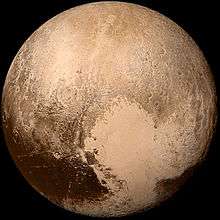2010 RE64
| Discovery[1] | |
|---|---|
| Discovered by |
D. Rabinowitz M. E. Schwamb S. Tourtellotte European Southern Observatory, La Silla (809) |
| Discovery date | 2010-09-09 |
| Designations | |
| MPC designation | 2010 RE64 |
| TNO / SDO[2] | |
| Orbital characteristics[3] | |
| Epoch 13 January 2016 (JD 2457400.5) | |
| Uncertainty parameter 5 | |
| Observation arc | 1504 days (4.12 yr) |
| Aphelion | 94.803 AU (14.1823 Tm) (Q) |
| Perihelion | 36.074 AU (5.3966 Tm) (q) |
| 65.438 AU (9.7894 Tm) (a) | |
| Eccentricity | 0.44874 (e) |
| 529.37 yr (193351 d) | |
| 318.55° (M) | |
| 0° 0m 6.703s /day (n) | |
| Inclination | 13.541° (i) |
| 67.400° (Ω) | |
| 21.326° (ω) | |
| Earth MOID | 35.0932 AU (5.24987 Tm) |
| Jupiter MOID | 30.9681 AU (4.63276 Tm) |
| Physical characteristics | |
| Dimensions |
370–820 km[3][4] 612 km[5][6] |
| 21.7[7] | |
| 4.3[3] | |
|
| |
2010 RE64, also written as 2010 RE64, is a scattered disc object with an absolute magnitude of 4.3.[3] Mike Brown's website lists it as a highly likely dwarf planet.[8]
Preliminary
It has an observation arc of 407 days,[3] and there are currently no known precovery images to help refine its orbit. It is currently 53.7 AU from the Sun.[7] Based on JPL's best-fit solution for the orbit, it reached aphelion around 1829. It is estimated to come to perihelion around 2079.[3]
Assuming a generic trans-Neptunian albedo of 0.09, it is about 612 kilometres (380 mi) in diameter.[5] However, since the true albedo is unknown and it has an absolute magnitude of 4.3,[3] it could easily be from about 370 to 820 km in diameter.[4]
References
- ↑ "MPEC 2010-T36 : 2010 RE64". IAU Minor Planet Center. 2010-10-06. Retrieved 2011-07-06.
- ↑ Marc W. Buie. "Orbit Fit and Astrometric record for 10RE64" (last observation: 2011-10-21 using 16 of 16 observations over 1.1 yr). SwRI (Space Science Department). Retrieved 2009-12-03.
- 1 2 3 4 5 6 7 "JPL Small-Body Database Browser: (2010 RE64)" (last observation: 2011-10-21; arc: 1.11 years). Retrieved 31 March 2016.
- 1 2 "Absolute Magnitude (H)". NASA/JPL. Archived from the original on 26 November 2009. Retrieved 2009-12-06.
- 1 2 Dan Bruton. "Conversion of Absolute Magnitude to Diameter for Minor Planets". Department of Physics & Astronomy (Stephen F. Austin State University). Retrieved 2010-12-03.
- ↑ Assuming an albedo of 0.09
- 1 2 "AstDyS 2010 RE64 Ephemerides". Department of Mathematics, University of Pisa, Italy. Retrieved 2014-03-28.
- ↑ Michael E. Brown. "How many dwarf planets are there in the outer solar system? (updates daily)". California Institute of Technology. Archived from the original on 2011-10-18. Retrieved 2011-08-25.
External links
- Orbital simulation from JPL (Java) / Horizons Ephemeris
- 2010 RE64 at the JPL Small-Body Database

This article is issued from Wikipedia - version of the 9/21/2016. The text is available under the Creative Commons Attribution/Share Alike but additional terms may apply for the media files.
_(cropped).jpg)
